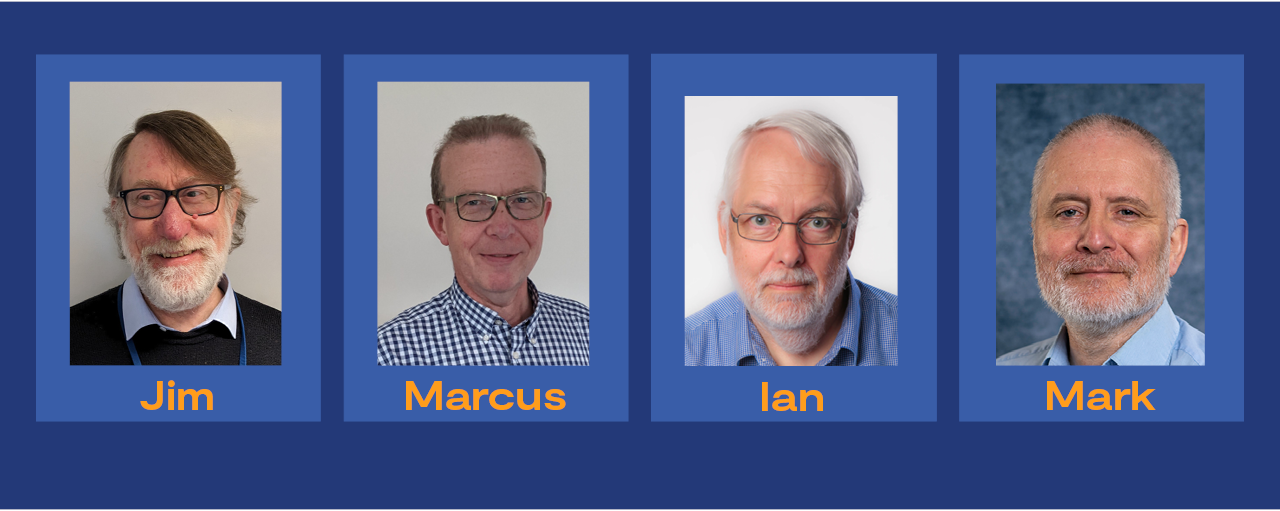We would love to introduce you to our division heads: Jim Halliday, Marcus French, Ian Lazarus, and Mark Willoughby. Read more about each of their stories...
 Our lovely division heads...
Our lovely division heads...
.
Jim Halliday
Head of Applied Science
Jim has been the head of our Applied Science Division since May 2019. After gaining his BSc in Environmental Sciences from East Anglia, he worked as a Systems Analyst for British Airways before joining Rutherford Appleton Laboratory's
Energy Research Unit. Jim has worked in renewable energy R&D for many years, has been awarded a PhD in Applied Physics, served twice as the National Chairman of the British Wind Energy Association (now
RenewableUk), and has been the head of our Energy Research Unit since 1992. He has carried out a range of research projects while working here at RAL - his first project in the 1980s found that wind-generated electricity could make a significant contribution to UK electricity generation, while the ERU's latest project examines the potential of
green ammonia. The Applied Science Division has many skills – manufacturing, technical, analytical, engineering, scientific, and computational - which are applied to a wide range of projects, both internal to STFC and external, with national and international collaborators, serving the physics, space, and energy communities. ASD Groups also develop new ideas and processes for possible commercialisation. Outside of his work at STFC, Jim has served as a local Councillor and is a past Mayor of Abingdon-on-Thames - he has even taken part in
Abingdon's famous bun-throwing!
Marcus French
Head of Detectors and Electronics
Marcus joined the lab in late 1986 after graduating from Warwick University, joining the micro-electronics group and working in teams developing chips for particle physics, nuclear physics, space instrumentation, synchrotron machines, and free electron lasers. Some of his major projects have included the
CERN CMS tracker and calorimeter readout systems. Today, Marcus leads a vibrant division whose programme of work is underpinned by STFC’s first accredited ISO9000 quality system. This includes complex hybrid pixel detector systems for new facilities, as well as breakthrough projects in the field of electron microscopy and photon science. Today the division, in partnership with our facility departments, delivers instrumentation solutions across all our national and many international facilities including
CERN,
ISIS,
Diamond,
CLF,
FAIR,
RAL Space,
ESS and
SKA. Marcus also leads the
STFC national lab Centre for Instrumentation programme which provides seed corn funding to drive the development of our next-generation technologies and systems. Outside STFC he is an active member of Christchurch in Abingdon and is a keen amateur pianist.
Ian Lazarus
Head of Technology at Daresbury
After a couple of years in the telecoms industry, Ian joined Daresbury Laboratory as an electronics engineer in 1982. His first projects involved designing electronics for computer systems, before specialising in designing data acquisition and instrumentation systems, initially for the Nuclear Structure Facility and Synchrotron Radiation Source Facility located at Daresbury. Later he led international electronics teams for the Euroball and AGATA gamma-ray spectroscopy arrays used at nuclear physics labs including
Strasbourg,
Legnaro,
GSI, and
GANIL in Caen. More recently, he was the technical coordinator for the design and installation of the
ISOLDE Solenoidal Spectrometer at CERN. Ian went on to become our Nuclear Physics group leader and then, in 2018, he became head of the Technology at Daresbury division. The division comprises physicists, engineers, and technicians who work together in two main areas. Firstly, to work with partners including
ASTeC,
CERN, and
ESS, to build particle accelerators and secondly to build advanced instrumentation for synchrotrons, nuclear and particle physics. When he’s not working, Ian keeps busy as a lay preacher in the Church of England and relaxes by walking near lakes and mountains with his wife and his camera.
Mark Willoughby
Head of Microelectronics Support Centre
Mark joined the lab in 1990, after completing a BEng in Electrical and Electronic Engineering at Nottingham Trent University. His entire career has been as part of the UKRI
Micro-electronics Support Centre (MSC), which he now leads. The MSC is an international centre of excellence in microelectronics design flows and allied areas from TCAD to system integration. Its major project is Europractice, where it is the sole partner responsible for the supply and support of commercial microelectronics design tools to European academics and leads the skills activity. In addition to academic activities, the MSC is very active in assisting university spinouts in microelectronics. Outside of work, Mark wonders why he has so little time outside of work and is never happier than when he has his head in a book.
This article was originally written and posted on our LinkedIn page.
Written by Catherine Lewin-Williams.
